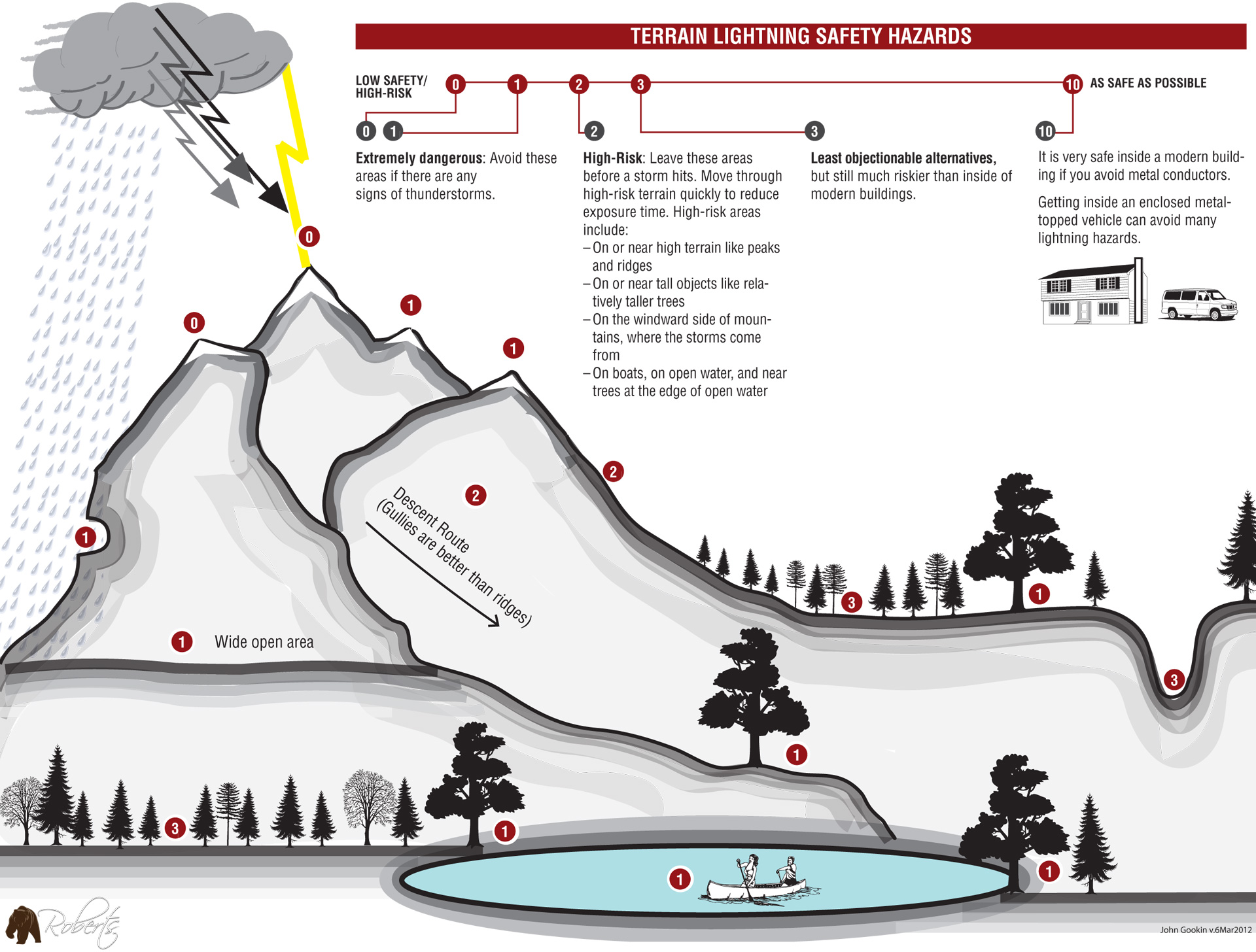No place outdoors is safe from lightning. Lightning is an objective hazard. Your behavior can reduce the risk of that hazard harming you.
Backcountry settings are at least a 30-minute walk from the nearest vehicles or modern buildings, where you can easily find safe shelter. There are four actions that can reduce your lightning risk in the backcountry, but none of them can make you as safe as getting in a modern building or a metal-topped vehicle. These behaviors are listed in order, and each is roughly twice as important as the next.
TIME YOUR VISITS TO HIGH-RISK AREAS WITH LOCAL WEATHER PATTERNS
Timing activities with safe weather requires knowledge of both typical and recent local weather patterns. There is no such thing as a surprise or freak storm. You must set turnaround times that will get you off of exposed terrain before storms arrive. You need to observe the changing weather and discuss its status with your group. If you have logistical delays, you may need to change your plan rather than summiting a peak or crossing open ground during a thunderstorm. Begin your turnaround if you hear thunder (which means lightning is less than 10 miles away).
FIND SAFER TERRAIN IF YOU HEAR THUNDER
Safer terrain in the backcountry can decrease your chances of being struck. Lightning tends to hit high points and the surrounding terrain. Avoid peaks, ridges, and significantly higher ground during an electrical storm. If you have a choice, descend a mountain on the side that has no clouds over it, since strikes tend to be less frequent on that side until the clouds move over it. Once you get down to low, rolling terrain, strikes are so random you shouldn’t worry about terrain as much. Move to safer terrain as soon as you hear thunder, not when the storm is upon you.
Select tent sites that may reduce your chances of being struck or affected by ground current. If you are in a tent in “safer terrain” and you hear thunder, you at least need to be in the lightning position. Lying flat increases the risk of injury by ground current.
If your tent is in a more dangerous location, such as on a ridge, in a broad open area, or near a tall tree, you must exit the tent and get to safer terrain before the storm arrives, and stay there until it has passed.
In gently rolling hills, lower flat areas are not safer than the higher flat areas because none of the gentle terrain attracts leaders. Strikes are random in this terrain. Look for a dry ravine or other significant depression to reduce risk.
The flash-bang ranging system measures how far away a thunderstorm is, but sometimes it is impossible to tell which flash is associated with which bang. The flash of light travels fast enough that it is virtually instantaneous. The sound travels a mile every five seconds (1km/3 sec) so ideally you just count the number of seconds between the obvious flash and the obvious bang, and divide by five to determine how many miles away the storm is. Divide the time by three to see how many kilometers distant the storm is. Do not stake your life on the reliability of this ranging system.
AVOID TREES AND LONG CONDUCTORS ONCE LIGHTNING GETS CLOSE
Wide open ground offers high exposure to lightning. Avoid trees and bushes that rise above others, since the highest objects tend to generate upward leaders. Your best bet is to look for an obvious ravine or depression before the storm hits, then spread out your group at 20 foot (7m) intervals to reduce the risk of multiple injuries. Assume the lightning position.
Cavers should avoid cave entrances during thunderstorms. Small overhangs can allow arcs to cross the gap. Natural caves that go far into the ground can be struck, either via the entrance or through the ground. People have been shocked standing in water half a mile inside caves. If you are caving near an entrance during electrical activity, don’t stand in water, avoid metal conductors like ladders, cables, and railings, and avoid bridging the gap between ceiling and floor.
Boaters need to start getting off the water long before a storm arrives. Avoid tall trees near the edge of the water.
GET IN THE LIGHTNING POSITION IF LIGHTNING IS STRIKING NEARBY AND YOU CAN’T GET TO SAFER TERRAIN
The lightning position is for waiting out storms in stationary situations when it is impractical to move to a safer location. It is important to reduce your overall footprint on the ground .



